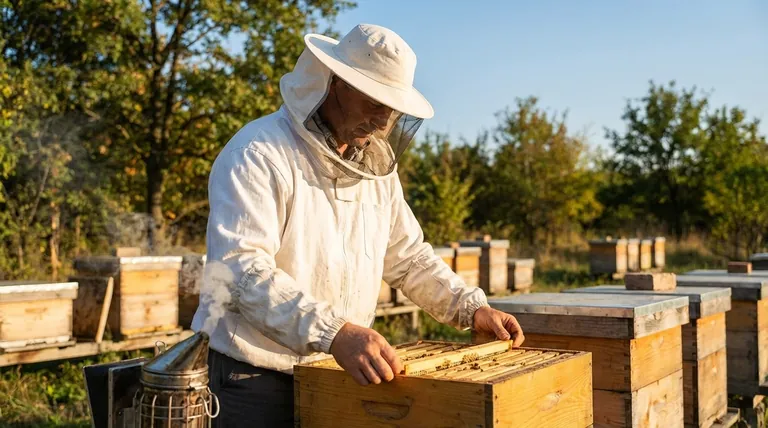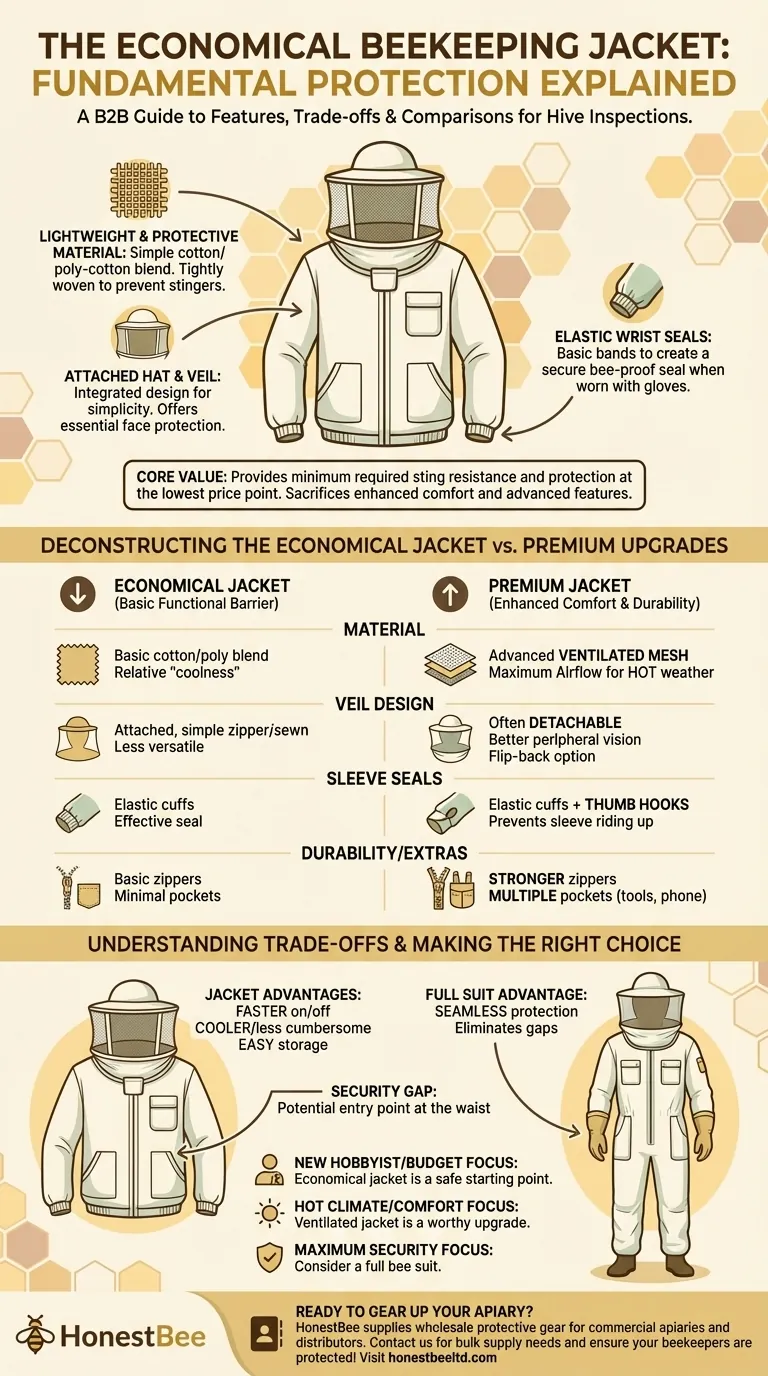In short, an economical beekeeping jacket provides fundamental protection with a few key features. It is constructed from a cool, lightweight material designed to be sting-protective, includes an attached hat and veil, and has elastic bands at the wrists to create a secure seal against bees.
An economical beekeeping jacket offers the minimum required protection for hive inspections. While it covers the essentials like sting resistance and a veil, it often sacrifices the enhanced comfort, durability, and convenience features found in more advanced models.

Deconstructing the Economical Jacket
An economical jacket is designed to provide a functional barrier at the lowest possible price point. Understanding its specific features helps clarify what you are—and are not—getting.
Material: Lightweight and Protective
The core of the jacket is a simple fabric, often a cotton or poly-cotton blend. This material is woven tightly enough to prevent bee stingers from penetrating, providing the essential protection you need.
While described as "lightweight" and "cool," this is relative to thicker, non-breathable materials. It does not typically include the advanced, multi-layer ventilated mesh found in premium jackets.
Veil: Attached for Simplicity
These jackets almost always come with an attached hat and veil. The veil may be permanently sewn on or attached with a basic zipper.
This integrated design is simple and cost-effective. However, it offers less versatility than the fully detachable, round-style veils on premium jackets, which often provide better peripheral vision and can be flipped back or removed for a drink.
Seals: Elastic Wrists
To prevent bees from crawling up your sleeves, economical jackets rely on simple elastic bands at the cuffs. This is a basic but effective method for creating a seal when you pull your gloves on over the jacket sleeves.
What You Gain by Upgrading: Premium Features
To understand the value of an economical jacket, it's helpful to see what features are typically added at higher price points. These additions focus on comfort, durability, and user convenience.
Enhanced Comfort: Ventilated Fabrics
The most significant upgrade is a ventilated jacket. These are made of a three-layer mesh that allows for maximum airflow while still preventing stings, making work in hot weather far more comfortable.
Superior Sealing: Thumb Hooks
More expensive jackets often include thumb hooks or loops at the end of the sleeves. This small feature is a major quality-of-life improvement, as it keeps the sleeve from riding up your arm as you pull on your gloves, ensuring a secure, bee-proof seal every time.
Durability and Convenience: Zippers and Pockets
Premium jackets feature stronger, more reliable zippers, especially around the veil, which is a common point of failure. They also typically include multiple, well-placed pockets for carrying hive tools, queen markers, or your phone.
Understanding the Trade-offs: Jacket vs. Full Suit
Choosing an economical jacket is just one part of the decision. You must also decide if a jacket—of any kind—is right for you compared to a full bee suit.
Speed and Ease of Use
A jacket is much faster to put on and take off than a full suit. This makes it ideal for quick hive inspections or brief tasks in the bee yard.
Comfort and Storage
Being less material, a jacket is cooler and less cumbersome to wear than a full one-piece suit. It is also much easier to store.
The Security Gap
The primary trade-off is protection. A jacket leaves a gap at the waist between the jacket and your pants. While this can be managed by tucking it in, it represents a potential entry point for bees that a seamless full suit eliminates.
Making the Right Choice for Your Goal
Selecting protective gear is about balancing your budget, climate, and personal comfort with bees.
- If your primary focus is budget and you're a new hobbyist: The economical jacket is a perfectly acceptable and safe starting point for learning and performing basic inspections.
- If your primary focus is comfort during frequent work in hot climates: Investing in a ventilated jacket will dramatically improve your beekeeping experience and is a worthwhile upgrade.
- If your primary focus is maximum security and peace of mind: Consider a full bee suit instead of a jacket to eliminate any potential gaps in your protection.
Ultimately, the best choice provides the level of protection you need to feel confident and comfortable while working with your bees.
Summary Table:
| Feature | Economical Jacket | Premium Jacket |
|---|---|---|
| Core Material | Basic cotton/poly blend | Advanced ventilated mesh |
| Veil Design | Attached, simple | Often detachable, better vision |
| Sleeve Seals | Elastic cuffs | Elastic cuffs + thumb hooks |
| Durability/Extras | Basic zippers, minimal pockets | Stronger zippers, multiple pockets |
Ready to gear up your apiary with reliable, cost-effective protection?
Whether you're a commercial apiary or a beekeeping equipment distributor, HONESTBEE supplies the protective gear you need to operate safely and efficiently. Our wholesale-focused operations ensure you get high-quality beekeeping jackets and supplies at competitive prices.
Contact HONESTBEE today to discuss your bulk supply needs and let us help you protect your most valuable asset—your beekeepers!
Visual Guide

Related Products
- Cotton Beekeeping Suit and Round Hat with Veil Bee Keeper Protective Gear
- Economy Polyester Beekeeping Jacket with Veil and Hat
- Beekeeping Jacket with Hood and Veil for Beekeepers
- White Beekeeping Protective Suit and Hat with Fencing Veil for Beekeepers
- Heavy Duty Cowboy Beekeeper Hat with Visibility Veil Outdoor Professional Beekeeping Protective Gear
People Also Ask
- Do beekeeping suits completely prevent stings? Maximize Your Apiary Safety with the Right Gear
- What are bee suits made of? Choosing the Right Material for Maximum Protection & Comfort
- How should a bee suit be cleaned? Protect Your Investment and Ensure Apiary Safety
- What should be considered regarding the color of beekeeping clothing? Ensure Your Safety and Keep Bees Calm
- What is recommended for beginners in beekeeping regarding protective clothing? A Complete Safety Guide for New Beekeepers



















